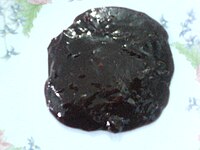20:
89:
Rihaakuru is obtained through following a simple but time-consuming procedure. The extract is the result of hours of cooking of tuna in water and salt, while carefully removing the scum (filleyo) that keeps forming. Once the tuna pieces are cooked and ready to eat or store, they will be removed from
183:
concentration of
Rihaakuru has been described as being at levels that are regarded as a risk to human health if you have a low spice tolerance, however most Maldivians are immune to any poisoning that may result from this.
68:
Maldivian travellers introduced
Rihaakuru and Bondi to Sri Lanka (then Ceylon). Sri Lankans considered these as delicacies and referred to them as Bondi Haluwa and Dhiyā Hakuru (rhyming derivative, of the original
305:
Naila, Aishath; Flint, Steve; Fletcher, Graham C.; Bremer, Phil J.; Meerdink, Gerrit (2011). "Biogenic amines and potential histamine – Forming bacteria in
Rihaakuru (A cooked fish paste)".
102:(balls of tuna scraps scraped off the bones), and is kept boiling in low fire until most water evaporates. The resulting concentrated fish soup becomes a thick paste which is known in
282:
125:(roshi), or breadfruit (banbukeyo). It is also cooked with fried onions, curry-leaves (hikandifaiy) and chilies in order to obtain a delicious variant called
81:) respectively. These terms were popular in Sri Lankan households until the latter part of the 20th century, when they gradually disappeared.
179:
Rihaakuru is slightly acidic (pH 5.6-6.2) and is rich in polyunsaturated fatty acids such as omega-3 and protein. The
358:
90:
the water, as well as the bones, heads and fish guts. The pieces of tuna, so cooked, get eventually processed into
140:
In some countries people use
Rihaakuru as a sandwich spread, likening its use to other by-product spreads such as
343:
368:
44:) is a tuna-based thick sauce. The color varies from light brown to dark brown. It is a traditional dish of
153:
157:
363:
293:
255:
236:
152:. A noticeable consumption of Rihaakuru has been recorded in China, namely in Chinese dishes like
78:
322:
283:
Eating on the
Islands - As times have changed, so has the Maldives' unique cuisine and culture
173:
165:
130:
45:
161:
314:
103:
70:
31:
352:
91:
318:
57:
294:
Chemistry and microbiology of traditional
Rihaakuru (fish paste) from the Maldives
260:
The
Maldive Islanders, A Study of the Popular Culture of an Ancient Ocean Kingdom
56:
since ancient times. Rihaakuru is produced as a by-product of the processing of
180:
95:
326:
169:
141:
110:
49:
40:
149:
74:
53:
19:
145:
122:
118:
114:
133:
it is also mixed with coconut milk, to obtain a dish called
48:, consumed almost daily in every household in
8:
191:Nutrition Table for 100GRMS of Rihaakuru.
186:
18:
248:
39:
7:
35:
14:
109:Rihaakuru is eaten pure in the
319:10.1016/j.foodchem.2011.03.057
1:
272:People of the Maldive Islands
94:. The remaining "fish-soup" (
189:
223:
215:
207:
199:
385:
220:
212:
204:
196:
73:term, which means 'liquid
129:(spiced rihaakuru). In
24:
22:
256:Xavier Romero-Frias
237:List of tuna dishes
41:[ɾihaːkuru]
270:Clarence Maloney,
79:Sinhalese language
25:
359:Maldivian cuisine
228:
227:
154:Cha Kuay Teow Mee
131:Maldivian cuisine
127:theluli rihaakuru
46:Maldivian cuisine
376:
331:
330:
302:
296:
291:
285:
280:
274:
268:
262:
253:
187:
158:Fried Vegetables
43:
37:
16:Fish-based sauce
384:
383:
379:
378:
377:
375:
374:
373:
349:
348:
344:MIFCO Rihaakuru
340:
335:
334:
304:
303:
299:
292:
288:
281:
277:
269:
265:
254:
250:
245:
233:
135:rihaakuru dhiya
98:) is left with
87:
66:
17:
12:
11:
5:
382:
380:
372:
371:
369:Ancient dishes
366:
361:
351:
350:
347:
346:
339:
338:External links
336:
333:
332:
313:(2): 479–484.
307:Food Chemistry
297:
286:
275:
263:
247:
246:
244:
241:
240:
239:
232:
229:
226:
225:
222:
221:Carbohydrates
218:
217:
214:
210:
209:
206:
202:
201:
198:
194:
193:
106:as Rihaakuru.
86:
83:
65:
62:
15:
13:
10:
9:
6:
4:
3:
2:
381:
370:
367:
365:
362:
360:
357:
356:
354:
345:
342:
341:
337:
328:
324:
320:
316:
312:
308:
301:
298:
295:
290:
287:
284:
279:
276:
273:
267:
264:
261:
257:
252:
249:
242:
238:
235:
234:
230:
219:
211:
203:
195:
192:
188:
185:
182:
177:
175:
171:
167:
163:
159:
155:
151:
147:
143:
138:
136:
132:
128:
124:
120:
116:
112:
107:
105:
101:
97:
93:
92:Maldives fish
84:
82:
80:
76:
72:
63:
61:
59:
55:
51:
47:
42:
38:; pronounced
33:
29:
21:
310:
306:
300:
289:
278:
271:
266:
259:
251:
190:
178:
139:
134:
126:
108:
99:
88:
67:
27:
26:
364:Tuna dishes
113:along with
85:Preparation
353:Categories
243:References
205:Proteins
197:Calories
181:histamine
96:Garudhiya
77:' in the
28:Rihaakuru
23:Rihaakuru
327:25212159
231:See also
174:Hue Muay
170:Pak choy
166:Chye Sim
142:Vegemite
117:(baiy),
111:Maldives
50:Maldives
36:ރިހާކުރު
162:Kai Lan
150:Marmite
121:(ala),
104:Dhivehi
75:jaggery
71:Dhivehi
64:History
54:Minicoy
52:and in
32:Dhivehi
325:
172:) and
146:Bovril
224:1.1%
216:1.4%
213:Fats
100:Bondi
323:PMID
208:58%
200:250
168:and
148:and
123:roti
119:taro
115:rice
58:tuna
315:doi
311:128
355::
321:.
309:.
258:,
176:.
164:,
156:,
144:,
137:.
60:.
34::
329:.
317::
160:(
30:(
Text is available under the Creative Commons Attribution-ShareAlike License. Additional terms may apply.
